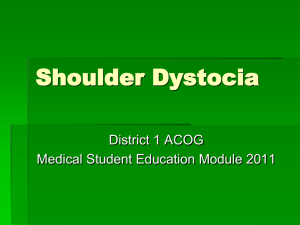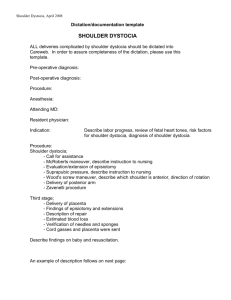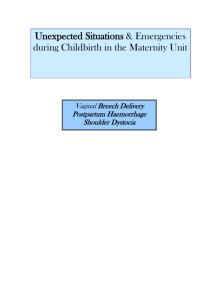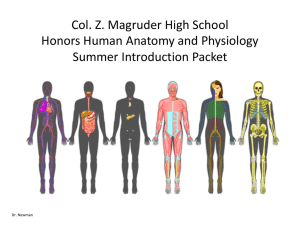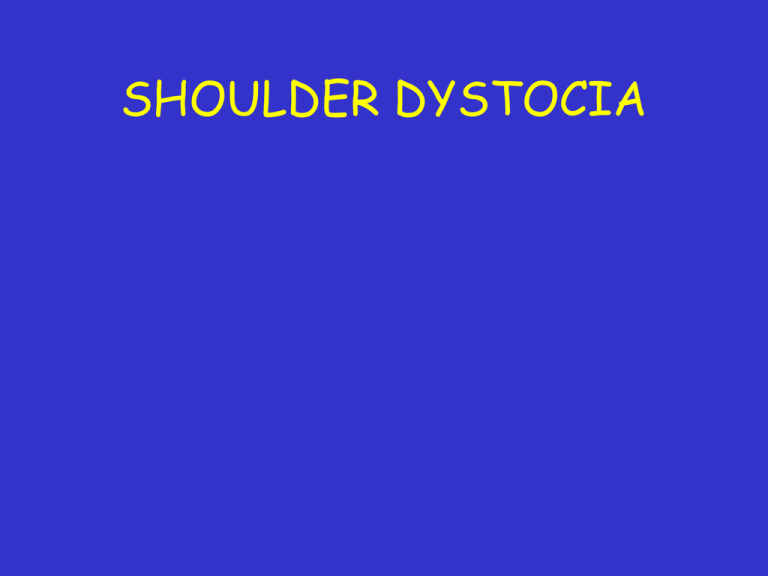
SHOULDER DYSTOCIA
OBJECTIVES
• Recognize risk factors for shoulder
dystocia
• Utilize a systematic approach to
managing shoulder dystocia
• Demonstrate appropriate manoeuvres
to reduce a shoulder dystocia using
the HELPERR mnemonic
BACKGROUND
• Impaction of the anterior shoulder against
the symphysis after delivery of the fetal
head
• Incidence – varies by birthweight
- 0.3% in infants weighing 2500-4000 grams
- 5-7% in infants weighing 4000-4500 grams
• ≥50% occur in normal weight infants.
RISK FACTORS
• Prior shoulder
dystocia
• Gestational diabetes
• Postdates pregnancy
• Macrosomia
• Maternal short
stature
• High Pregnancy weight
and weight gain
• Abnormal pelvic
anatomy
• 1st stage
protraction or
arrest disorders
• Prolonged 2nd stage
• “Head bobbing” in
2nd stage
• Instrumental
vaginal delivery
COMPLICATIONS
• Maternal
– soft tissue injuries
– anal sphincter
damage
– postpartum
haemorrhage
– uterine rupture
– symphyseal
separation
• Neonatal
– brachial plexus
palsy
– clavicle fracture
– humeral fracture
– fetal acidosis
– hypoxic brain injury
PREVENTION
• Elective caesarean delivery NOT indicated
• Glycaemia control
• Weight control
– Preconceptual and during pregnancy
• Deliver in alternative positions or
McRoberts
• Deliver anterior shoulder with momentum
of head delivery
RECOGNITION
• Fetal head retracts against perineum
(“turtle sign”)
• Gentle traction does not effect
delivery
• Proceed to HELPERR
HELPERR mnemonic
•
•
•
•
•
•
•
H = Help (call for additional assistance)
E = Evaluate for episiotomy
L = Legs (McRoberts Maneuver)
P = Pressure (suprapubic)
E = Enter the vagina
R = Roll the patient (to hand and knees)
R = Remove the posterior arm
H = Help
• Activate institutional protocol
– Appropriate notification
– Additional nursing staff
– Additional back-up
• neonatal resuscitation personnel
• obstetrical/surgical backup
• anaesthesia
E = Evaluate for Episiotomy
• Shoulder dystocia is not a soft-tissue
dystocia
• Consider when additional room needed
for advanced manoeuvres
• Decision based on clinical judgement
and response to initial manoeuvres
L = Legs
• McRoberts Manoeuvre:
– Flex maternal hips so that thighs are on
abdomen
• Effects:
– Straightens the lumbosacral lordosis
– Increases AP diameter of pelvis
– Flexes the fetal spine
• Reduces 40% of shoulder dystocias
Mc Roberts
P = Pressure
• Suprapubic pressure by assistant:
– CPR–style hand position
– Force should act to adduct anterior
shoulder
– Initially continuous, but can involve a
rocking motion
– Attempt for 30-60 seconds
E = Enter
• Rubin Manoeuvre
– Approach anterior fetal shoulder from
behind
– Exert pressure on scapula to adduct
most accessible shoulder and rotate to
oblique position
– Continue McRoberts manoeuvre
E = Enter (II)
• Woods Screw Manoeuvre
– Approach posterior fetal shoulder from
the front
– Gently rotate shoulder toward symphysis
– Combine with Rubin manoeuvre
• Birth attendant has one hand on each
shoulder, rotating together
E = Enter (III)
• Reverse Woods Screw Manoeuvre
– Approach h posterior shoulder from
behind
– Rotate fetus in opposite direction from
Rubin or Woods Screw manoeuvres
– May be successful when previous
manoeuvres fail
R = Remove the Arm
•Follow posterior arm down
to elbow
–Usually anterior to fetal chest
•Flex arm at the elbow
•Sweep forearm across
fetal chest
– grasping hand directly and
pulling outward may lead to
fractures
R = Roll the Patient
• Roll patient to “all fours” position
• Increases pelvic diameters
• Movement and gravity may also
contribute to dislodging the impaction
• Deliver posterior shoulder with gentle
downward traction
Manoeuvres of Last Resort
•
•
•
•
•
Deliberate clavicle fracture
Zavanelli manoeuvre
Muscle relaxation
Abdominal surgery with hysterotomy
Symphysiotomy
Zavanelli Manoeuvre
• Cephalic replacement followed by
emergency caesarean delivery
• Flex fetal head to replace
• Requires anaesthesia, OR team,
tocolysis
• Do not attempt if nuchal cord
clamped and cut

